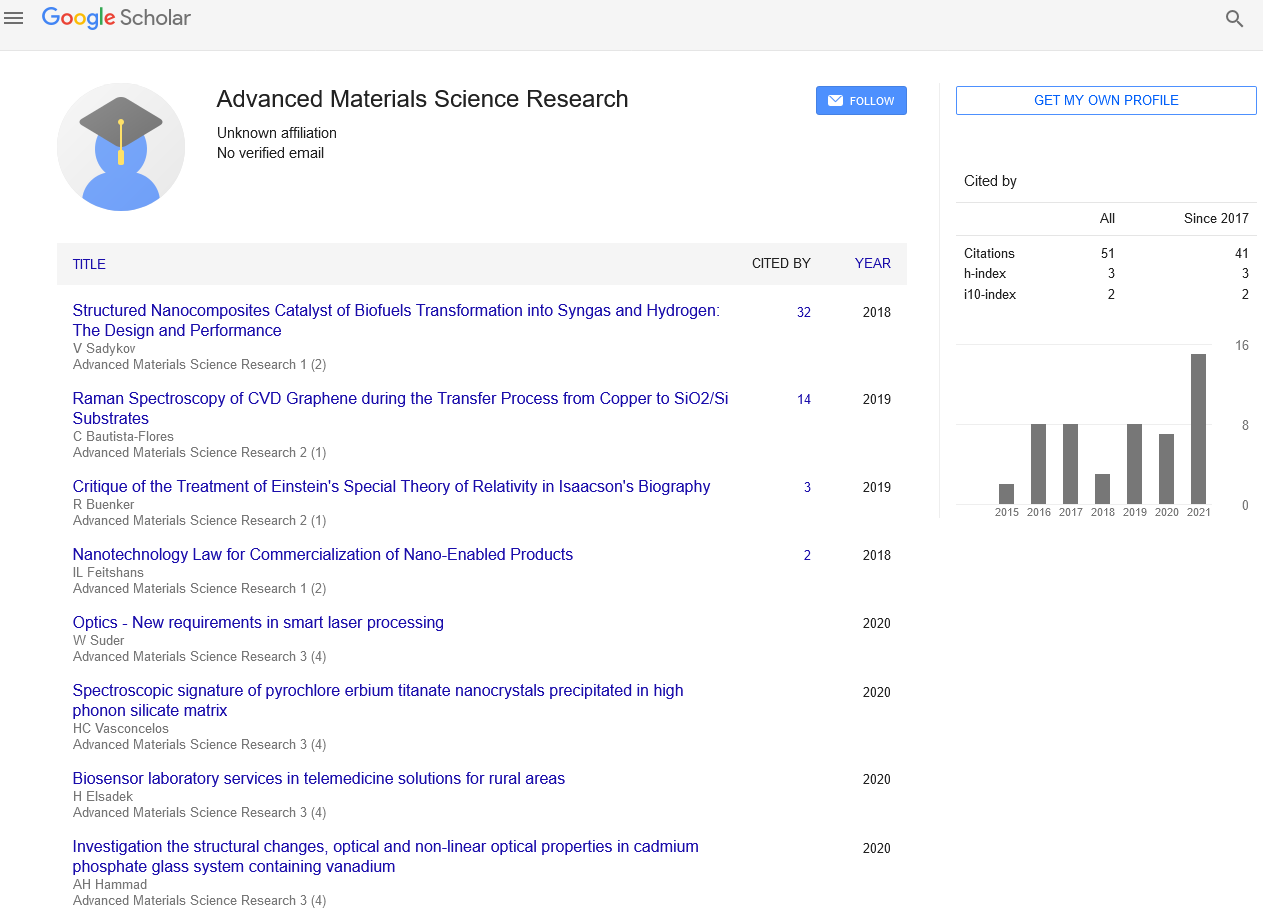Mini Review - Advanced Materials Science Research (2023) Volume 6, Issue 2
A Short Note on Simulation of Soft Ferromagnetic Materials
Velten Fletcher*
Department of biological and biomedical materials, Australia
Department of biological and biomedical materials, Australia
E-mail: Fletcher_v7@gmail.com
Received: 03-Apr-2023, Manuscript No. aaamsr-23-96387; Editor assigned: 05-Apr-2023, Pre-QC No. aaamsr-23-96387 (PQ); Reviewed: 19- Apr-2023, QC No. aaamsr-23-96387; Revised: 21-Apr-2023, Manuscript No. aaamsr-23-96387 (R); Published: 28-Apr-2023; DOI: 10.37532/ aaasmr.2023.6(2).25-27
Abstract
Electrical resistivity measurement is widely used to evaluate the self-sensing capability of conductive fiber-reinforced cement composites and to characterize various phases of cement composites. In order to investigate the properties of cement composites, the electrode parameters, including material, layout, and fixing style, need to be carefully chosen because the electrodes play a significant role in measuring the resistivity. The electrical behavior of cement mortars was evaluated and contrasted using three distinct materials as electrodes in this investigation. The desired electrode material was identified by qualitatively comparing the results in terms of resolution, sensitivity, and noise fluctuations. In addition, the polarization and depolarization zones of specimens containing various fractions of silica fume were examined in order to evaluate the effect of silica fume on the measured values. As demonstrated by the results, the percentage of silica fume replacement had an effect on electrical polarization and depolarization, making brass an appealing option for use as an electrode due to its short response time and low current fluctuations.
Keywords
Ferromagnetic Materials • Fiber-reinforced cement
Introduction
Knowing the mechanical and chemical properties of these composites and evaluating their short-term and long-term behavior are without a doubt becoming increasingly important in the modern world and the vast industry of high-rise buildings, where concrete and cement composites are increasingly used. The electrical resistivity of concrete was one of the first nondestructive cementitious matrix tests.
One of the simplest and most efficient methods for measuring the strength of concrete without destroying it or requiring access to the depth of the specimen is the Wenner method, which was first proposed by Frank Wenner in 1916. One of the first works in the field of cementitious composites' electrical resistivity was Tamas's research at the beginning of the 1980s. Using a conductogram, he examined the conductivity of cement pastes from the beginning of the hydration process to the paste's full-scale hardening. One of the most important sources for electrical evaluation of pozzolanic reactions is his studies. Tumidjasky continued his research on Tamas. He explored electrical conductivity of mortars in 1996 and found connection between electrical conductivity and total volume division.
Impedance spectroscopy, or electrical measurement with alternating current, was first applied to cement composites in the 1990s. Morris et al. employed the Wenner method. Carried out practical studies on concrete cylinders, which are one of the primary sources for current Wenner tests. Steadily, complete investigations of Wenner strategy and contrasting it and different techniques supported the unwavering quality of Wenner strategy in estimating electrical resistivity of cement and examining the properties of chloride particle entrance.
Cement composites' dielectric (capacitive) properties have been the subject of research since the 1980s. Perez-pina and others can be referenced as the trailblazers of this field. They performed nondamaging trials on superior execution composites interestingly and concentrated on capacitive impact by decreasing water/concrete proportion to 0.17. One of the primary areas of interest for researchers in this field has gradually evolved into the capacitive effect of cement composites.
Research plans like polarity switching of DC current for investigating capacitive effect gained popularity among experts in this field after the disadvantages and limitations of frequency measurement systems were discovered. These studies include the Wen and Chung studies. They looked at how stress affected the polarization of cement and a carbon fiber-reinforced cement matrix to see how this fiber affected the results of research. Their further examination in 2006 thought about the impact of immediate and rotating current and showed that by involving direct current in exceptionally brief timeframes, comparable outcomes to substituting current can be gotten [1-5].
Discussion
Comparing to the anode material, the most famous material is copper. In any case, a few examinations have been done utilizing different sorts of cathodes, for example, metal drop, silver paint alongside copper wire and treated steel. It may be possible to measure electrical resistivity with greater precision by comparing the magnitude and fluctuation of noise between various electrode materials. Three distinct kinds of materials were utilized as electrodes in this study, all with the same geometry and probe spacing. Examples containing different vol. At various ages, from 28 days to 2 years, percentages of silica fume were subjected to an electrical resistivity test. Additionally, at the age of two, the specimens were tested to see how the electrode material affected current flow before and after polarity switching. Directing these tests would be powerful in exploring the way of behaving of silica rage in concrete framework in lengthy run. Additionally, by contrasting the electrical way of behaving of the examples when extremity exchanging by utilizing different cathode materials, the anode by which best reaction could be not entirely settled.
From measurements of the effective conductivities of this material saturated with several conductive liquids, we develop a method to determine the thermal or electrical conductivity of the skeleton of a porous material with known porosity. The term "conductivity of the skeleton" refers to the conductivity of the skeleton material, which, in the case of a granular substance, is responsible for the conductivity that exists between the grains. The concept of equivalent microstructure serves as the foundation for the strategy. Type S Glass Beads (https://www.swarco.com/ceroglass/ Products/Wet-Grinding-Milling-Beads/, 2019).
The research is motivated by requirements in applied science, particularly geomechanics and biomechanics, where measuring the properties of materials like mineralized collagen or rock skeleton may be challenging. When materials are manufactured using in-situ technologies in additive manufacturing. Advanced experimental methods that enable the measurement of the properties of small parts of the material may form the basis of a potential solution. it's obvious, for instance, Constantinides, Ravi Chandran, Ulm and Van Vliet, 2006, Singh, Chawla, Tang and Shen, 2010), or on the answer for backwards issues of homogenization.
Reverse issues of micromechanics generally show up with regards to recuperation of either microstructural data from the viable properties and properties of constituents or data about properties of the constituents from the deliberate powerful properties and known convergences of the stages. Since inverse problems are ill-posed, it is uncertain to extract information from effective properties in either case. The type of the overall anisotropy has a significant impact on the degree of uncertainty; It decreases when only part of the microstructure (volume fraction of phases, average shape of defects or inhomogeneities, etc.) is known. becomes readily available on her own.The inverse technique was used by Brennan, Bentsen, and Hasselman to evaluate the thermal conductivity and diffusivity of thin fibers based on experimental data for the heat transport properties of a suitable composite that included the fibers and the properties of the matrix. In order to identify the best components for composites with specified elastic and piezoelectric properties, Sevostianov and Sevostianov, Gorbatikh, and Kachanov utilized the approach of inverse problems. Based on the effectivemedium homogenization technique, Nan et al. (2004) proposed a method to determine the Kapitza matrix–reinforcement interfacial thermal resistance and constituent thermal conductivities from the composites' measured effective thermal conductivity. Al-Sulaiman, Al-Nassar, and Mokheimer suggested using measurements of the thermal conductivities of the fiber-reinforced composite laminates and the resin materials to estimate the thermal conductivity of the fibers. Their strategy represents the presence of voids in the material [6-10].
Conclusion
A numerical–analytical method was developed by Rahmani, Mortazavi, Villemure, and Levesque to evaluate the mechanical properties of the components of a two-phase composite based on full-field measured displacement data. They zeroed in generally on the clamor in the deliberate information. The Levenberg– Marquardt method was used by Herrera-Solaz, Llorca, Dogan, Karaman, and Segurado to evaluate the mechanical properties of single crystals based on the experimental results of the mechanical behavior of polycrystals. Beluch and Burczynski utilized FEM based homogenization method and transformative calculation to decide flexible properties of the constituents in unidirectionally fiber-supported composites. A novel approach to determining a precise lower bound for the conductivity of the more conductive component in a two-phase material with any arbitrary microstructure was developed by Pelster, Hallouet, and Volz. Ogierman used an evolutionary algorithm to reconstruct the isotropic elastic constants of composites reinforced with short fibers and cubic particles using effective Young's modulus and Poisson's ratio. From the measurement of effective properties, Trofimov, Abaimov, and Sevostianov evaluated the thermal end elastic properties of small particles in a matrix composite using inversions of the Maxwell and Mori-Tanaka methods. The strategy has been applied for issues of geomechanics by Popov et al.
References
- Chutinan S, Platt J, Cochran M et al. Volumetric dimensional change of six direct core materials.Dent Mater.20, 345–351 (2004).
- Hayashi J, Espigares J, Takagaki T et al. Real-time in-depth imaging of gap formation inbulk-fill resin composites.Dent. Mater.35, 585–596 (2004).
- Tais Welter Meereis C, Aldrighi Münchow E, Luiz de Oliveira da Rosa W et al. shrinkage stress of resin-based dental materials: A systematic review and meta-analyses of composition strategies.J Mech Behav Biomed Mater.82, 268–281 (2018).
- Hardy C, Bebelman S, Leloup G et al. Investigating the limits of resin-based lutingcomposite photopolymerization through variousthicknesses of indirect restorative materials.Dent Mater.34, 1278–1288 (2018).
- Luiz BKM, Amboni RDMC, Henrique L et al. Influence of drinks on resin composite: Evaluation of degree of cure and color change parameters.Polym. Test. 26, 438–444 (2007).
- Toledano M, Vallecillo-Rivas M, Aguilera FS et al. Polymeric zinc-doped nanoparticles for high performance in restorative dentistry.J Dent.107, 103616 (2021).
- Par M, Spanovic N, Bjelovucic R et al. Curing potential of experimental resin composites with systematically varying amount of bioactive glass: Degree of conversion, light transmittance and depth of cure.J Dent. 75, 113–120 (2018).
- Simila HO, Boccaccini AR. Sol-gel bioactive glass containing biomaterials for restorative dentistry: A review.Dent. Mater.38, 725–747 (2022).
- Sgarbi SC, Kossatz Pereira S, Habith Martins JM et al. Degree of conversion of resin composites light activated by halogen light and led analyzed by ultraviolet spectrometry.Rev Clín Pesq Odontol.6, 223–230 (2010).
- Al-Gharrawi HAS, Wael Saeed M. Static Stress Analysis for Three Different Types of Composite Materials Experimentally and Numerically.Int J Sci Eng Res. 7, 498–504 (2016).
Google Scholar, Crossref, Indexed at
Google Scholar, Crossref, Indexed at
Google Scholar, Crossref, Indexed at

